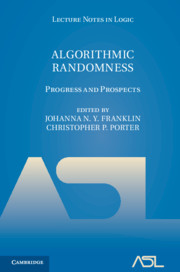Refine search
Actions for selected content:
48381 results in Computer Science
DETERMINISTIC INVESTMENT STRATEGY IN A DC PENSION PLAN WITH INFLATION RISK UNDER MEAN-VARIANCE CRITERION
-
- Journal:
- Probability in the Engineering and Informational Sciences / Volume 36 / Issue 1 / January 2022
- Published online by Cambridge University Press:
- 12 May 2020, pp. 201-216
-
- Article
- Export citation
A sparsity preserving genetic algorithm for extracting diverse functional 3D designs from deep generative neural networks
- Part of
-
- Journal:
- Design Science / Volume 6 / 2020
- Published online by Cambridge University Press:
- 12 May 2020, e11
-
- Article
-
- You have access
- Open access
- HTML
- Export citation
Boosting Answer Set Optimization with Weighted Comparator Networks
-
- Journal:
- Theory and Practice of Logic Programming / Volume 20 / Issue 4 / July 2020
- Published online by Cambridge University Press:
- 11 May 2020, pp. 512-551
-
- Article
- Export citation
Local algebraic effect theories
- Part of
-
- Journal:
- Journal of Functional Programming / Volume 30 / 2020
- Published online by Cambridge University Press:
- 11 May 2020, e13
-
- Article
-
- You have access
- Export citation
Is having an educationally diverse social network good for health?
-
- Journal:
- Network Science / Volume 8 / Issue 3 / September 2020
- Published online by Cambridge University Press:
- 11 May 2020, pp. 418-444
-
- Article
- Export citation
Cognition and communication: situational awareness and tie preservation in disrupted task environments
-
- Journal:
- Network Science / Volume 8 / Issue 4 / December 2020
- Published online by Cambridge University Press:
- 11 May 2020, pp. 508-542
-
- Article
- Export citation

Excel Basics to Blackbelt
- An Accelerated Guide to Decision Support Designs
-
- Published online:
- 08 May 2020
- Print publication:
- 28 May 2020
VOLATILITY ANALYSIS OF REGIME-SWITCHING MODELS
-
- Journal:
- Probability in the Engineering and Informational Sciences / Volume 35 / Issue 4 / October 2021
- Published online by Cambridge University Press:
- 08 May 2020, pp. 928-941
-
- Article
- Export citation
Denotational semantics for guarded dependent type theory
-
- Journal:
- Mathematical Structures in Computer Science / Volume 30 / Issue 4 / April 2020
- Published online by Cambridge University Press:
- 08 May 2020, pp. 342-378
-
- Article
- Export citation
A survey on blockchain-based platforms for IoT use-cases
- Part of
-
- Journal:
- The Knowledge Engineering Review / Volume 35 / 2020
- Published online by Cambridge University Press:
- 08 May 2020, e19
-
- Article
- Export citation

Algorithmic Randomness
- Progress and Prospects
-
- Published online:
- 07 May 2020
- Print publication:
- 07 May 2020
Notes
-
- Book:
- Human-Robot Interaction
- Published online:
- 20 February 2020
- Print publication:
- 07 May 2020, pp 252-252
-
- Chapter
- Export citation
8 - Higher randomness
-
-
- Book:
- Algorithmic Randomness
- Published online:
- 07 May 2020
- Print publication:
- 07 May 2020, pp 232-300
-
- Chapter
- Export citation
Frontmatter
-
- Book:
- Human-Robot Interaction
- Published online:
- 20 February 2020
- Print publication:
- 07 May 2020, pp i-iv
-
- Chapter
- Export citation
Fault-tolerant functional reactive programming (extended version)
- Part of
-
- Journal:
- Journal of Functional Programming / Volume 30 / 2020
- Published online by Cambridge University Press:
- 07 May 2020, e12
-
- Article
-
- You have access
- Export citation
2 - What Is Human–Robot Interaction?
-
- Book:
- Human-Robot Interaction
- Published online:
- 20 February 2020
- Print publication:
- 07 May 2020, pp 6-17
-
- Chapter
- Export citation
9 - Research Methods
-
- Book:
- Human-Robot Interaction
- Published online:
- 20 February 2020
- Print publication:
- 07 May 2020, pp 126-160
-
- Chapter
- Export citation
5 - Subroutines and Modules
-
- Book:
- Python for Linguists
- Published online:
- 20 April 2020
- Print publication:
- 07 May 2020, pp 81-116
-
- Chapter
- Export citation
1 - Key developments in algorithmic randomness
-
-
- Book:
- Algorithmic Randomness
- Published online:
- 07 May 2020
- Print publication:
- 07 May 2020, pp 1-39
-
- Chapter
- Export citation
